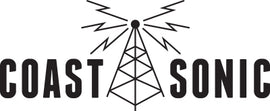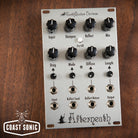EarthQuaker Devices Afterneath Eurorack Module *Custom color
Couldn't load pickup availability
Maker: EarthQuaker Devices
Model: Afterneath V3 Eurorack module
Condition: New
Description:
The Afterneath Eurorack Module brings the Otherworldly sounds from the effects pedal world right into your modular synthesizer with an expanded feature set. The Afterneath module features one main audio input, one main audio output, an audio send and return for the Reflect feedback path, and nine controls. Four of the parameters are controllable via CV, and each has been equipped with a dedicated attenuverter to process the incoming CV. The Afterneath module has a completely analog dry signal path and a totally digital wet signal path.
1. Input: Adjusts the level of the incoming signal to allow for signals ranging from instrument-level (clockwise) to modular-level (counterclockwise).
2. Dampen: Controls the tone of the wet signal. Clockwise for darker tones, counterclockwise for brighter tones.
3. Reflect: Controls the regeneration of the reverb, turn clockwise for more wash and echoes, counterclockwise for less. This will self-oscillate if turned up high. Acts as an attenuator when there is a signal patched into the Reflect Return jack.
4. Mix: Controls the amount of wet signal that is mixed with the dry signal. Though it does not actually go completely wet, you can achieve a fully wet signal by engaging the Dry Kill switch.
5. Dry Kill: Eliminates the dry signal from the output, leaving only the wet signal.
6. Drag: This digital reverb is made up of a bunch of short delays, Drag separates the delay lines creating a stuttering, pingy effect. This is the coolest control on the Afterneath; we highly advise slowly turning (or modulating) this while you let notes ring out for a cool warped speed effect. The effect is more delay-like as you turn it counterclockwise, and it is more reverb-like as you turn it clockwise. You will achieve shorter delay times as you move the control clockwise, and longer delay times when you turn the control counterclockwise. You will notice a change in pitch when adjusting this control with sound present in the effects buffer, or when the effect is self-oscillating.
7. Mode: Controls the behavior of the Drag control as well as how it responds to control voltage. There are 9 different modes (see the following Modes section for explanations).
8. Diffuse: Smooths and diffuses the delay repeats. Sharper transients with more attack counterclockwise, more ambient, reverb-like and washy as you turn it clockwise.
9. Length: Controls the decay length of the reverb.
10. Mode LED: Visually indicates the current mode.
11. Drag CV Attenuverter: Attenuates or inverts the incoming CV. The CV is at unity gain when the attenuator is fully clockwise, inverted when it is fully counterclockwise and the CV is completely attenuated when the attenuator is in the 12 o’clock position.
12. Mode CV Attenuverter: Attenuates or inverts the incoming CV. The CV is at unity gain when the attenuator is fully clockwise, inverted when it is fully counterclockwise and the CV is completely attenuated when the attenuator is in the 12 o’clock position.
13. Diffuse CV Attenuverter: Attenuates or inverts the incoming CV. The CV is at unity gain when the attenuator is fully clockwise, inverted when it is fully counterclockwise and the CV is completely attenuated when the attenuator is in the 12 o’clock position.
14. Length CV Attenuverter: Attenuates or inverts the incoming CV. The CV is at unity gain when the attenuator is fully clockwise, inverted when it is fully counterclockwise and the CV is completely attenuated when the attenuator is in the 12 o’clock position.
15. Drag CV Input: Allows modulation of the Drag control using external CV.
16. Mode CV Input: Allows modulation of the Mode control using external CV.
17. Diffuse CV Input: Allows modulation of the Diffuse control using external CV.
18. Length CV Input: Allows modulation of the Length control using external CV.
19. Audio Input: Accepts audio signals ranging from instrument-level to modular-level, using the Input knob to adjust the level.
20. Reflect Send: Allows external patching and processing of the Reflect feedback path. Patching from this output does not interrupt the internal feedback path.
21. Reflect Return: Allows return of the externally patched and processed Reflect feedback path. Also, it can be used as an additional audio input if you wish to forgo the feedback. The Reflect knob acts as an attenuator for the audio that is patched to this input. Please note that processing of the Reflect feedback path can easily result in self-oscillation when processing with effects such as distortion or a resonant filter. The Reflect knob can be used to compensate for this factor. Patching a cable to this input will disconnect the internal feedback path, but the Reflect Send will still be active.
22. Audio Output
Modes
1. Unquantized: Smooth, unquantized response over the operating range
2. Unquantized with Slew: Smooth, unquantized response over the entire operating range, but with a musical slew that is reminiscent of turning the varispeed knob on a vintage British tape delay. The “Drag” will lag behind the knob or CV changes, but then quickly catch up
3. Unquantized Volt/Octave: Smooth and unquantized, yet scaled to align with the 1v/octave curve to allow melodic modulation of audio in the buffer, or control the frequency of self-oscillation like a voltage controlled oscillator
4. Chromatic Scale: Quantized 1v/octave to the chromatic scale
5. Major Scale: Quantized 1v/octave to the major scale
6. Minor Scale: Quantized 1v/octave to the minor scale
7. Pentatonic Scale: Quantized 1v/octave to the pentatonic scale
8. Octaves & Fifths: Quantized 1v/octave to omit all but octaves and fifths
9. Octaves: Quantized 1v/octave to omit all but octaves



